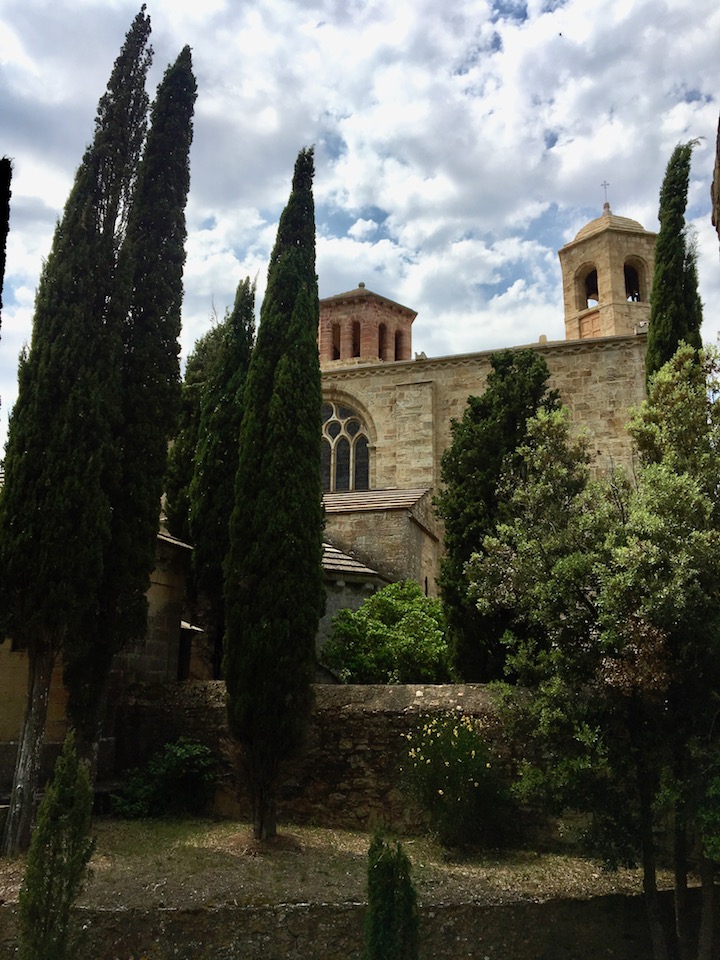 OK, 926 years. Old. The previous post focused on the gardens at the Abbaye de Fontfroide in the south of France. This time, we’re going inside.
OK, 926 years. Old. The previous post focused on the gardens at the Abbaye de Fontfroide in the south of France. This time, we’re going inside.

The abbey is founded in 1093. By 1145 it joins the Cistercian order, which itself starts at the Citeaux Abbey in Burgundy in 1098. Lots of monastic orders start in the 11th and 12th centuries. It was a turbulent time (when wasn’t it?) and people were searching for answers. Western Christian monasteries are based on the rules of St. Benedict of Nursia, who lived from 480 to 547, give or take. He didn’t become a saint until 1964 (two of his miracles involved avoiding being poisoned which makes me think of SNL’s Father Guido Sarducci describing a saint and saying two of the miracles were card tricks), but we’ll cut Benedict some slack because he was upset about the excesses of his time. Was it like the ’80s (not to mention Gordon Gekko…who was the villain! Not the hero!!!) the ’90s, the 2000s, the 2008 or was it–gasp–even worse?

The monks, about 80 of them plus 250 brother converts (except around 1438, when the Black Death cut their number to around 20…can you imagine?), are committed to hard physical labor, silence and poverty. The vow of poverty is one reason why, despite the huge size of Fontfroide, the decoration is austere, though you can pick out that later parts have faces, etc., though nothing as naughty as Saint-Hilaire. Even the columns in the cloister show only plants, not faces as you would see elsewhere.
 You would think that the vow of poverty and dedication to hard work would make Fontfroide’s monks find common cause with the Cathars, but in fact the crusade against the Cathars is set off by the assassination of Pierre de Castelnau, a Fontfroide monk who is the papal legate, sent to negotiate with the Cathars. Even before the actual battles begin, the Cistercians fight to stamp out the Cathar beliefs, though how they do this, stuck in a remote abbey and under a vow of silence, is unclear. I guess the lay brothers could talk, being the ones to leave the abbey walls to work, but they are lay–not all-in on the religion, though in that time everybody is all-in on the religion, like it or not. It dictates every aspect of everybody’s lives down to the smallest detail, no matter who you are, like in Iran today.
You would think that the vow of poverty and dedication to hard work would make Fontfroide’s monks find common cause with the Cathars, but in fact the crusade against the Cathars is set off by the assassination of Pierre de Castelnau, a Fontfroide monk who is the papal legate, sent to negotiate with the Cathars. Even before the actual battles begin, the Cistercians fight to stamp out the Cathar beliefs, though how they do this, stuck in a remote abbey and under a vow of silence, is unclear. I guess the lay brothers could talk, being the ones to leave the abbey walls to work, but they are lay–not all-in on the religion, though in that time everybody is all-in on the religion, like it or not. It dictates every aspect of everybody’s lives down to the smallest detail, no matter who you are, like in Iran today.  After the Cathar crusade, Fontfroide rises in prominence, thanks to Jacques Fournier, head abbot in 1311 (succeeding his uncle…nothing like a little nepotism). Fournier is named bishop of Pamiers in 1317 and is part of the Inquisition court trying Cathar holdouts (the crusade was in 1209, so they’re exacting revenge more than a century later!). He is then named bishop of Mirepoix, then is promoted to cardinal in 1327 and is elected pope in 1334. This happens during the Great Schism, or the Avignon papacy, from 1309 to 1376, when seven consecutive popes live in France, not Rome. In fact, it’s Fournier, as Pope Benedict XII, who builds the Palace of the Popes in Avignon, and he is buried in the Avignon cathedral.
After the Cathar crusade, Fontfroide rises in prominence, thanks to Jacques Fournier, head abbot in 1311 (succeeding his uncle…nothing like a little nepotism). Fournier is named bishop of Pamiers in 1317 and is part of the Inquisition court trying Cathar holdouts (the crusade was in 1209, so they’re exacting revenge more than a century later!). He is then named bishop of Mirepoix, then is promoted to cardinal in 1327 and is elected pope in 1334. This happens during the Great Schism, or the Avignon papacy, from 1309 to 1376, when seven consecutive popes live in France, not Rome. In fact, it’s Fournier, as Pope Benedict XII, who builds the Palace of the Popes in Avignon, and he is buried in the Avignon cathedral.  Things go downhill from there. More of the monks are nobles appointed to sinecures by the king and not very interested in monastic life. In fact, the so-called commendatory abbots suck up all the money of the abbey–and it covered 30,000 hectares between Béziers and Spain, versus 4,000 hectares today–to the extent that the real monks are probably in greater poverty than even they had signed up for. There are only seven monks left by 1594. About the same time, the non-religious monk-nobles build the fancier additions to the abbey, like the Court of Honor, built between the 16th and 17th centuries. They eat meat and chocolate (!!! a treat from newly discovered North America!) and play billiards. Can it be any worse? Sure it can–the church is one of the targets of the French Revolution in 1789, and the cushy noble-in-a-castle-that-pretends-to-be-an-abbey gig ends. The abbey is turned over to the Hospices of Narbonne in 1791. In 1833 the abbey is sold to the Saint-Aubin family, who want Eugène Viollet-le-Duc (the guy who restored la Cité of Carcassonne and Notre-Dame de Paris) to take it on. But it doesn’t work out.
Things go downhill from there. More of the monks are nobles appointed to sinecures by the king and not very interested in monastic life. In fact, the so-called commendatory abbots suck up all the money of the abbey–and it covered 30,000 hectares between Béziers and Spain, versus 4,000 hectares today–to the extent that the real monks are probably in greater poverty than even they had signed up for. There are only seven monks left by 1594. About the same time, the non-religious monk-nobles build the fancier additions to the abbey, like the Court of Honor, built between the 16th and 17th centuries. They eat meat and chocolate (!!! a treat from newly discovered North America!) and play billiards. Can it be any worse? Sure it can–the church is one of the targets of the French Revolution in 1789, and the cushy noble-in-a-castle-that-pretends-to-be-an-abbey gig ends. The abbey is turned over to the Hospices of Narbonne in 1791. In 1833 the abbey is sold to the Saint-Aubin family, who want Eugène Viollet-le-Duc (the guy who restored la Cité of Carcassonne and Notre-Dame de Paris) to take it on. But it doesn’t work out.

 By 1901, the last monks leave the abbey. It sits empty until 1908, when Gustave and Madeleine Fayet buy it at auction and start renovations. Gustave is a painter from a family of artists, and later adapts paintings into carpets, which are a big hit. Apparently, he also is an architect, industrialist, banker and winemaker. But to make money, it helps to already have money. Above all, he inherits an immense fortune from three generations of running barges on the Canal du Midi and transporting eau de vie–which better explain how he could afford such a project. He is so loaded that he buys another abbey as a gift for a female poet, because, hey, why not! Before buying Fontfroide, he flits around Europe and Algeria buying up art from the likes of Gauguin and Odilon Redon. In fact, he sells two Gauguins to a Russian collector in order to pay for the Fontfroide renovations in 1908, then in 1910 sells seven (!!!) works by Cézanne to fund more renovations. Meanwhile, he hosts musicians and artists, including Redon, who does a little decorating of the library while at the abbey. I found an article that called Fayet a cultural elitist, and it was meant as a compliment. So French.
By 1901, the last monks leave the abbey. It sits empty until 1908, when Gustave and Madeleine Fayet buy it at auction and start renovations. Gustave is a painter from a family of artists, and later adapts paintings into carpets, which are a big hit. Apparently, he also is an architect, industrialist, banker and winemaker. But to make money, it helps to already have money. Above all, he inherits an immense fortune from three generations of running barges on the Canal du Midi and transporting eau de vie–which better explain how he could afford such a project. He is so loaded that he buys another abbey as a gift for a female poet, because, hey, why not! Before buying Fontfroide, he flits around Europe and Algeria buying up art from the likes of Gauguin and Odilon Redon. In fact, he sells two Gauguins to a Russian collector in order to pay for the Fontfroide renovations in 1908, then in 1910 sells seven (!!!) works by Cézanne to fund more renovations. Meanwhile, he hosts musicians and artists, including Redon, who does a little decorating of the library while at the abbey. I found an article that called Fayet a cultural elitist, and it was meant as a compliment. So French.
Gustave Fayet died in 1925 in Carcassonne, and his wife, Madeleine died in 1971. The Fontfroide abbey is still operated today by descendants of Gustave and Madeleine.

Fontfroide isn’t related to the Cloisters that are part of the Metropolitan Museum of Art in New York. That said, the museum’s four cloisters were acquired from the general vicinity of Fontfroide–the abbey of Saint-Michel-de-Cuxa not far to the south, Saint-Guilhem-le-Désert just to the north, Bonnefont and Trie-en-Bigorre near Toulouse to the west. Those were bought by U.S. art dealer George Grey Barnard between 1934 and 1939, well after Fontfroide was in the Fayets’ hands.
 Fontfroide has two sets of interesting stained-glass windows. When Fayet bought the place, all the windows were destroyed. Traditionally, they would have been just grisaille, or gray, in keeping with the ascetic décor. In 1920, Fayet hired his buddy Réné Billa, alias Richard Burgsthal, to assemble collages from fragments of church windows in northern and eastern France that were destroyed in World War I. Very touching.
Fontfroide has two sets of interesting stained-glass windows. When Fayet bought the place, all the windows were destroyed. Traditionally, they would have been just grisaille, or gray, in keeping with the ascetic décor. In 1920, Fayet hired his buddy Réné Billa, alias Richard Burgsthal, to assemble collages from fragments of church windows in northern and eastern France that were destroyed in World War I. Very touching.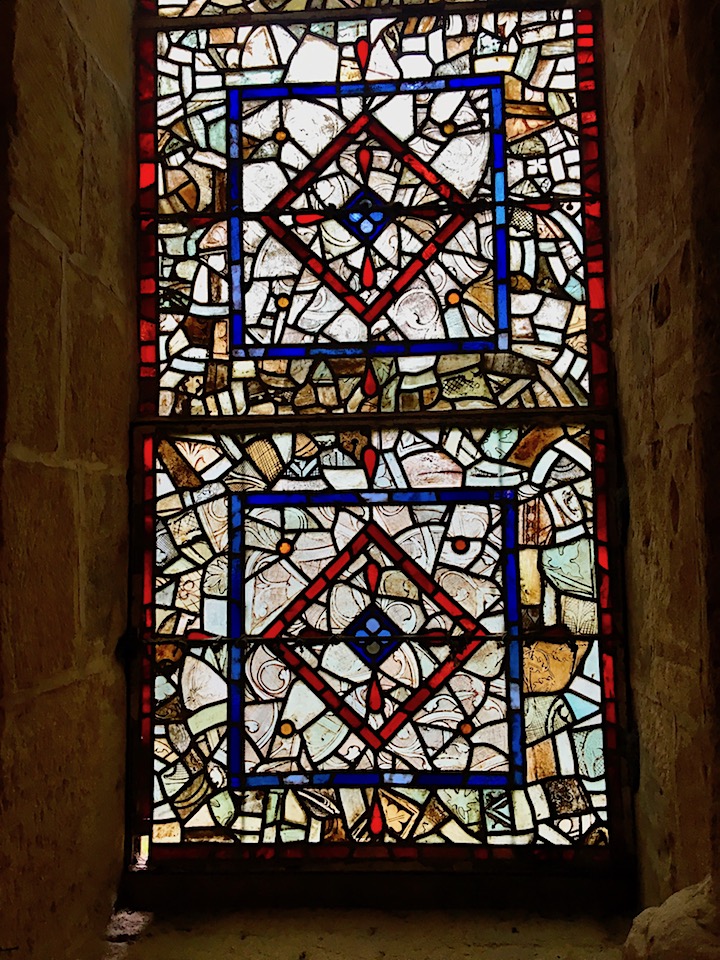

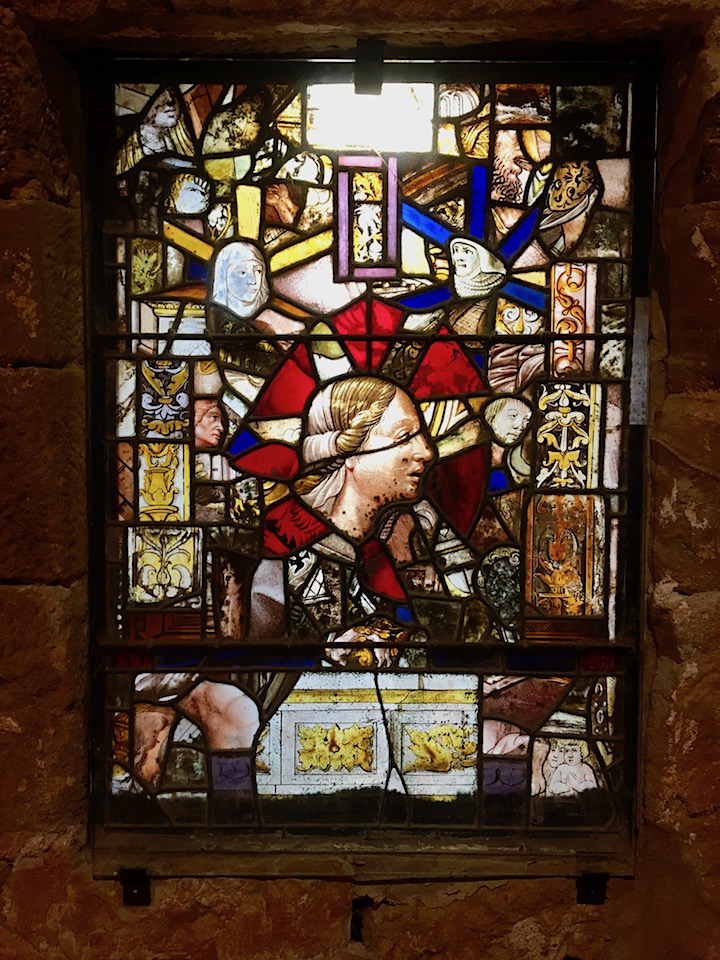 In the church and, especially its Chappelle des Morts (Chapel of Death), which overlooked the cemetery and was built during the plague, the windows are audacious, full of vibrant colors. In the church, they depict moments from the life of Saint Francis of Assisi. In the Chapel of Death, Father Kim en Joong in 2009 created contemporary abstract windows with deep reds and blues that make the dark space even more meditative. Sorry, but my photos didn’t turn out. (I have others!)
In the church and, especially its Chappelle des Morts (Chapel of Death), which overlooked the cemetery and was built during the plague, the windows are audacious, full of vibrant colors. In the church, they depict moments from the life of Saint Francis of Assisi. In the Chapel of Death, Father Kim en Joong in 2009 created contemporary abstract windows with deep reds and blues that make the dark space even more meditative. Sorry, but my photos didn’t turn out. (I have others!)

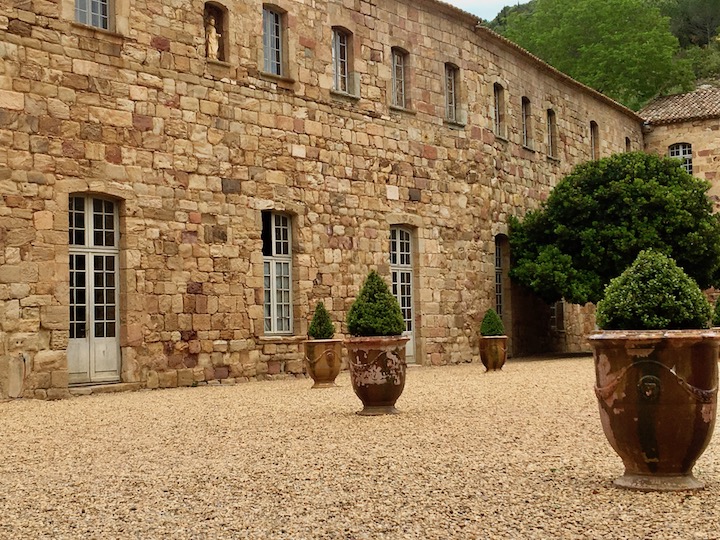
The central courtyard, or Louis XIV courtyard, is the site of workshops, from the forge to the joinery and bakery. There’s an underground cistern that provides very cold water–Fontfroide means cold spring. 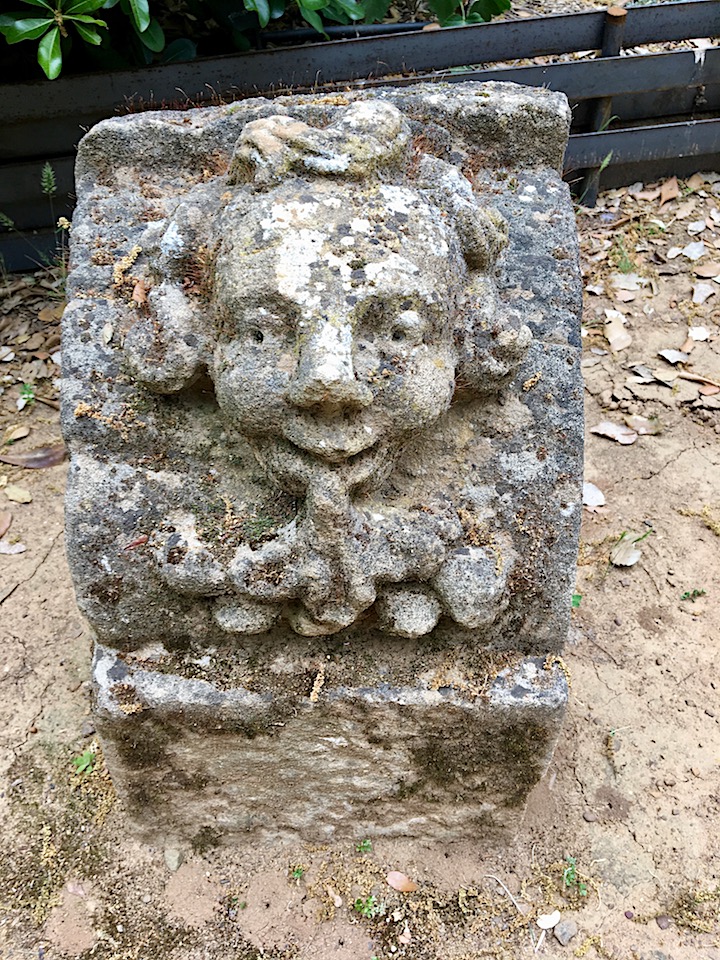

 So much to see. Big stuff and small details.
So much to see. Big stuff and small details.
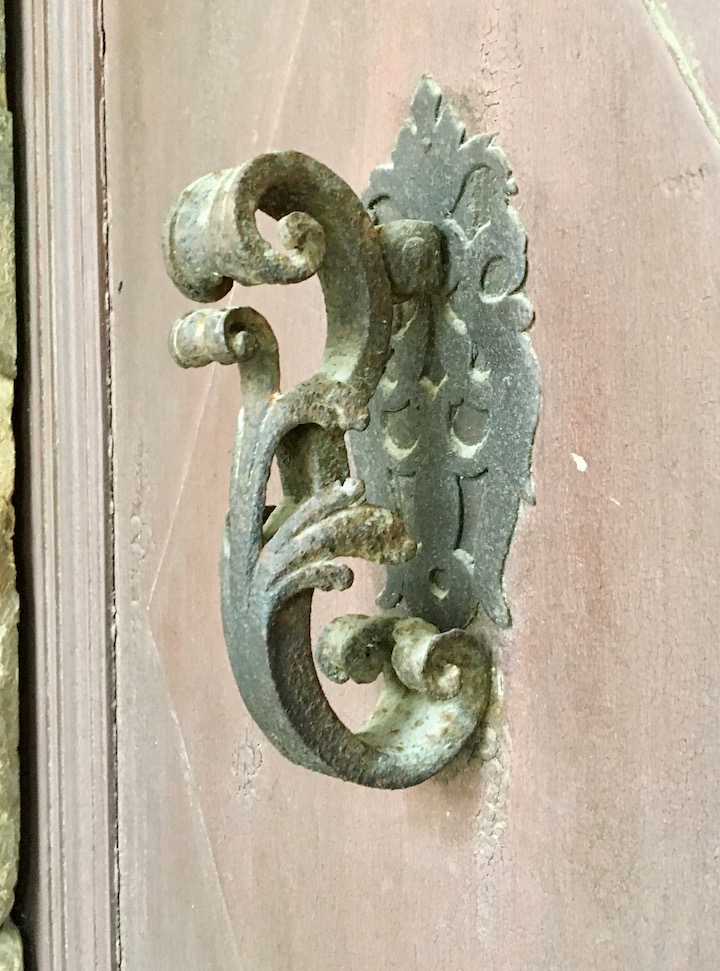





 Check out this drone video, which gives an idea of just how alone the abbey is in its setting.
Check out this drone video, which gives an idea of just how alone the abbey is in its setting.

I am really taken with the stained glass windows made with the remains of windows destroyed in the war. Amazing work! I was also excited to see the gardens in the video you directed us to. What a lovely place.
As always, thank you for sharing.
LikeLiked by 1 person
Aren’t they amazing? I am so glad the little bits found a new life. I wish I had gotten better photos of the modern stained-glass windows. Very different but beautiful, too.
LikeLiked by 1 person
I have some photos of the modern windows if you would like them. It would be more fun for you to go back for another visit though. It’s a beautiful place to explore.
I really enjoyed your article.
LikeLiked by 1 person
Yes, a return visit would be great!
LikeLike
Wow, just wow!!
LikeLiked by 2 people
🙂
LikeLike
I never thought I’d see Gordon Gecko and the plague in the same sentence, but it’s more fitting than you can possibly know. The character of Gordon Gecko was based on a real person, Asher Edelman, who buys companies and sells them off piece by piece. He bought one of the public companies my first husband started. I’ve had the misfortune of meeting Asher… He treated me like I was the one with the plague, not him. He walked off and left me standing there, talking to myself. Others told me not to take it personally. That’s just his charming nature. I love all of your photos and being able to see what has been restored. What an amazing story. xoxox, B
LikeLiked by 2 people
You have had quite an interesting life!
LikeLike
Quite a history to this place!
LikeLiked by 1 person
Indeed!
LikeLike
Thank you so much for putting this together for us to enjoy. Those windows! And the doors! Such history and so many human stories lie dormant in those broken pieces of glass, and the weathered boards.
LikeLiked by 1 person
That’s what draws us to these places, isn’t it? To listen to the whispers of the stories.
LikeLike
There is a lovely church in Meaford, Ontario, Canada that also has stained glass windows similarly created using remnants found by soldiers and gathered and shipped back to Canada after the second world war ….pictures and story can be found at this website:
http://www.meaford.com/town/church_anglican2.htm
LikeLiked by 2 people
Thank you for this. It’s so touching to think of the soldiers gathering the bits of glass. There are some towns in Normandy where the ruins were kept as is, to remind all of the devastation of war.
LikeLike
It’s a wonderful place!! One of the Fayet stories I heard (it might even have been in a book about him), is that he bought it because there was interest from the US in buying the cloister and having it shipped to New York. Whatever the reasons, it’s wonderful that the buildings have been saved and are accessible to the public today!
LikeLiked by 1 person
Another person brought that up, but I think it’s fake news. Fayet bought Fontfroide before WWI, whereas the cloisters that were shipped to New York to form the Cloisters museum were bought after WWII.
LikeLike
Fabulous,love all your historical research. Love your photographs, they bring it all alive.
LikeLiked by 1 person
Some of this stuff you just couldn’t make up, like buying an abbey for a friend!
LikeLike
Should I ever visit the Cathares again, I shall take your entire blog with me as a guide book. This is über-fantastic! Thank You. And the video is breathtakingly beautiful too!
I am always struck by the word FROIDE in the name – cold, in such a hot climate! Goes well with the austerity, doesn’t it?
LikeLiked by 1 person
It must have been welcome to find a cold spring. Font means fountain or spring…
LikeLiked by 1 person
yep – they found a fresh (cold) fountain/spring…. still, it makes me smile every time I read it!
LikeLiked by 1 person
Good!!! We need something cool and refreshing today.
LikeLiked by 1 person
The “n’importe quoi” photo has absolutely captivated me. Such mysterious layers!
LikeLiked by 1 person
It really makes you wonder what went on there!
LikeLike
I LOVE THIS TOUR and THAT VIDEO with the music!!!!!!!!
SO much history!
Happy to hear it is in GOOD HANDS NOW!What a beautiful job of restoring it!!
MERCI!
XX
LikeLiked by 1 person
The music is perfect with the soaring images.
LikeLiked by 1 person